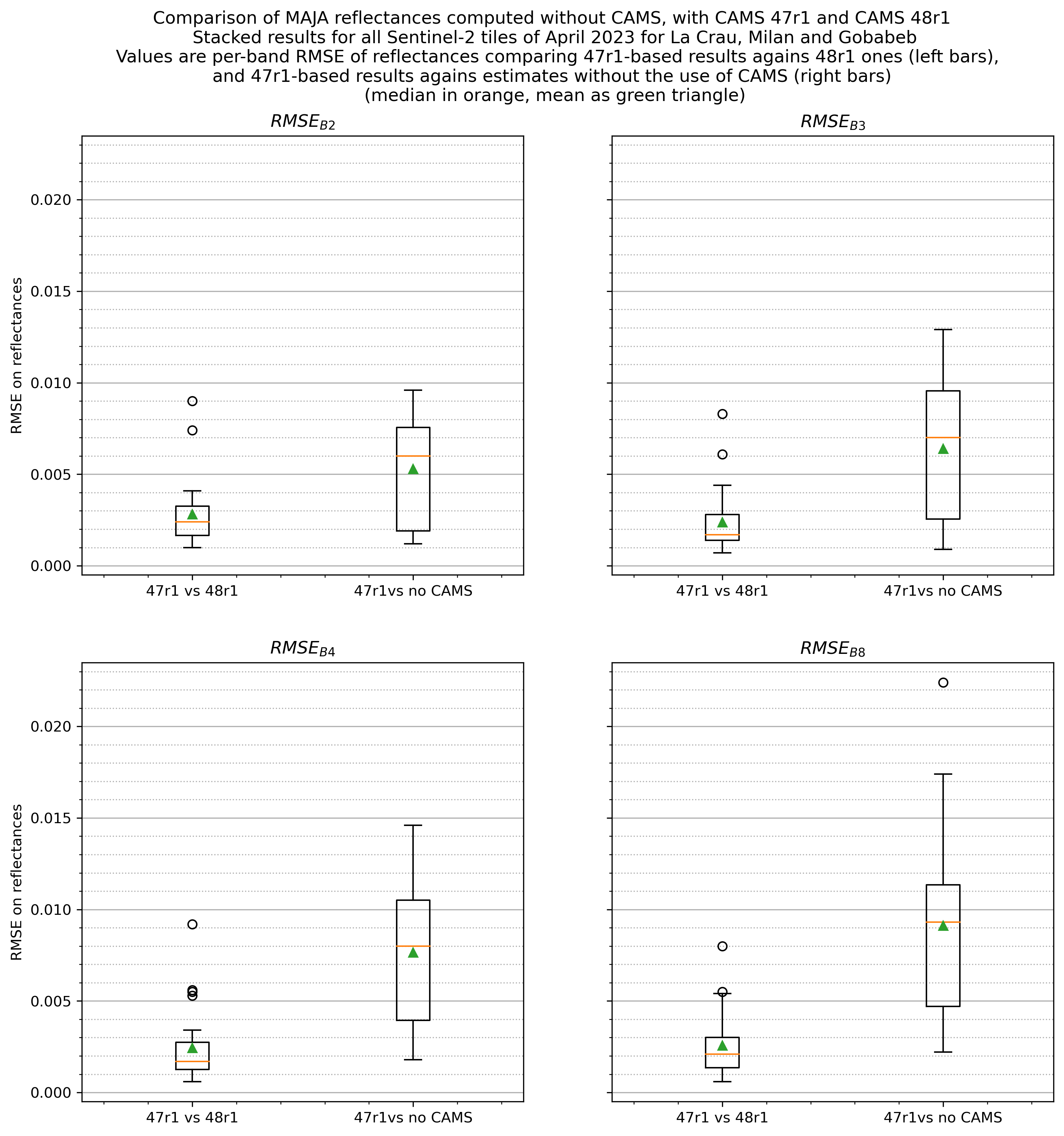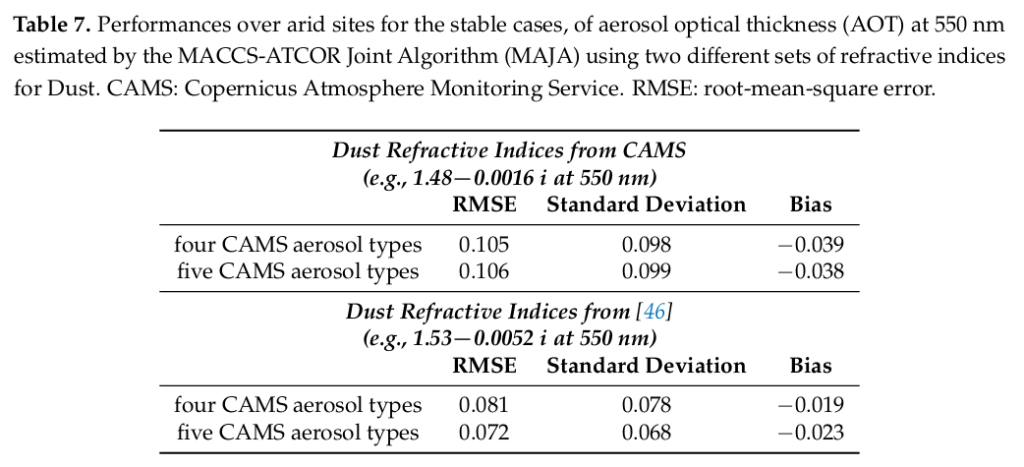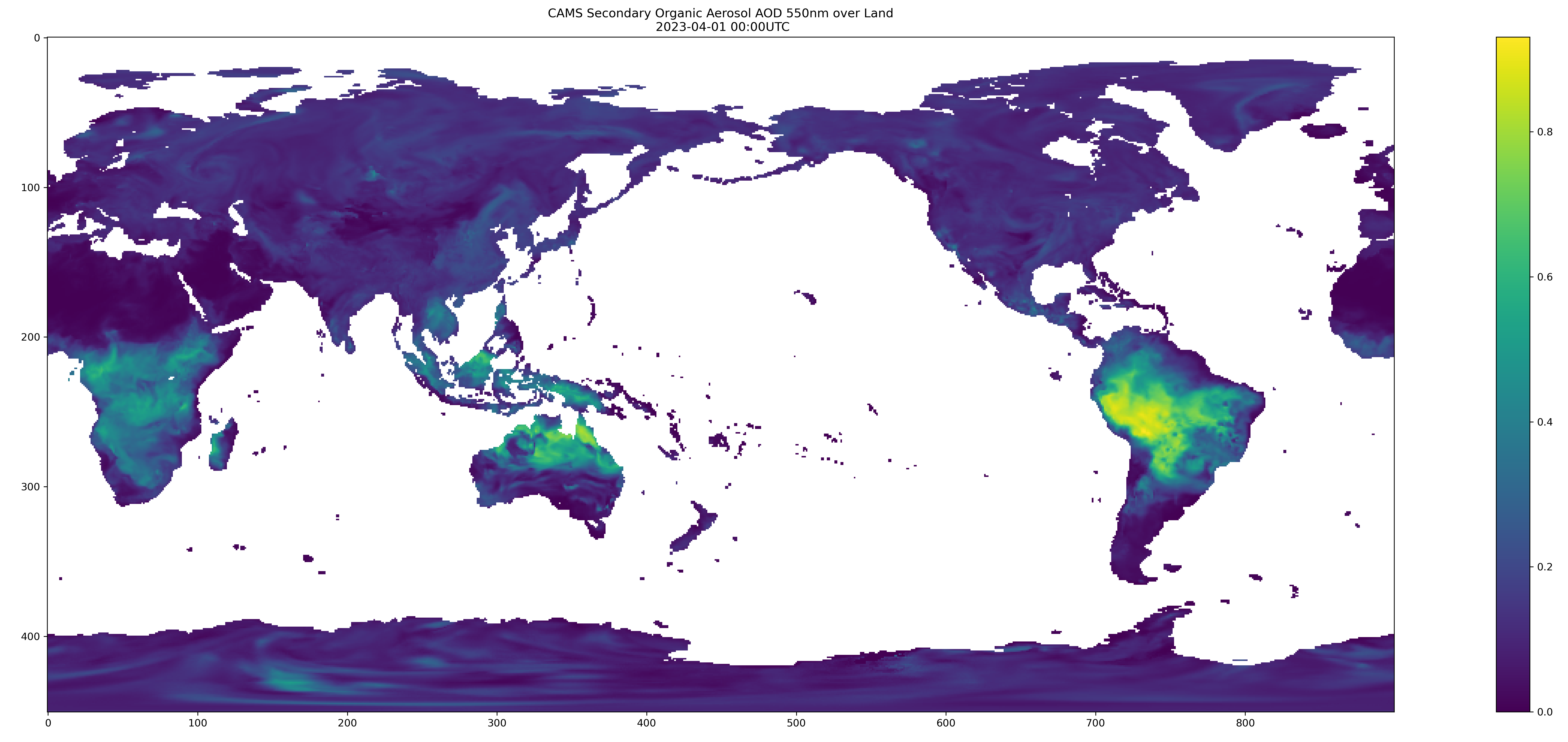An update on the use of CAMS 48r1
As announced in a previous post, the aerosol definition of the new 48r1 release of the CAMS auxiliary data has changed as compared to the former 47r1. At that time, we recommended to disable the use of CAMS data with MAJA before we adapt the code. Meanwhile, we have also tested the actual impact on the performance of the current version of MAJA, and found that reflectances estimates based on 48r1 are significantly closer to those with 47r1 than without using CAMS. Here are some more information.
To properly use the CAMS auxiliary data, MAJA relies on Look-up tables (LUT) computed with a radiative transfer model (RTM) to adequately account for aerosols optical properties, ie. their size distribution, their refractive index, and for the hydrophilic ones their growth factor along the relative humidity. With the latest CAMS release 48r1, the definition of Organic Matter species changed slightly, with a new Secondary Organic aerosol, and with new optical properties for Dust. To adapt and to test MAJA for such new definitions takes some time, but in the meantime one may ask : “What if I keep using my version of MAJA with the latest 48r1 CAMS data ?”. The short answer is “it’s pretty much as good”, but let’s have a look a little closer.
Using a CAMS 47r1 compliant version of MAJA (4.x) with 48r1 CAMS means :
- To keep downloading the Atmospheric Optical Depth (AOD) of the 7 previous species, without the new Secondary Organic Aerosol variables ;
- To keep using the 7-species LUT definitions.
From a technical point of view, it works seamlessly, since the IDs of the CAMS variables did not changed. Therefore, we performed a few runs of MAJA (version 4.6 here) using the 48r1 test data for the month of April 2023 on the tiles of La Crau (31TFJ), Gobabeb (33KWP) and Milan (32TNR), with each 12 L1C products. The same products were then computed with the 47r1 CAMS products, and without any CAMS data.
The following comparisons were performed on the surface reflectances of valid pixels (cloud-free, shadow-free, snow-free) between :
- 47r1-based reflectances against 48r1-based ones ;
- 47r1-based reflectances against “no CAMS data”-based ones.
The Figure below synthesises the obtained Root Mean Square Errors (RMSE) for Sentinel-2 bands 2, 3, 4 and 8, stacked for all valid pixels of all the L2A products of all sites.

What stands out of this Figure is that the surface reflectances obtained using the 48r1 CAMS data are significantly closer to the ones using the 47r1 CAMS data than those resulting from deactivating the CAMS option, whatever the band under consideration.
How can it be so ?
- The overall occurrence of Organic Matter in the aerosol mix may limit the impact of a change of its definition (in terms of optical properties and sub-species partitioning) ;
- The new optical properties of Dust are actually very close from the ones we used until now.
While the first point is an hypothesis than needs further investigation, the second is clearly documented. At the time of the implementation of the use of CAMS in MAJA, our former colleague B. Rouquié demonstrated that the use of the refractive index values for Dust from Woodward [1] lead to better estimates of the AOD than the values used by CAMS. The comparison was published in [2] and summarized in the following table:

Therefore, the MAJA Look-up Tables for Dust were computed using the Woodward refractive index. And the new Dust refractive index used in the CAMS 48r1 (1.53-0.0057 at 500nm) [3] is actually very close from the one we used in MAJA until now.
If we compare the AOD at 550nm computed by MAJA with the values measured at the ROSAS station of Gobabeb [4], we obtain the following :
| MAJA configuration | RMSE on AOD |
|---|---|
| no CAMS | 0.021 |
| 47r1 CAMS | 0.054 |
| 48r1 CAMS | 0.014 |
It’s worth keeping in mind that these later RMSEs on AOD are computed from only 11 values (the AOD value of the MAJA L2A product is taken at the location of the ROSAS station in each of the 11 cloud-free products). But it still tends to confirm that the existing Look-up Table for Dust is well suited to the latest CAMS products.
To conclude :
- The presented results are based on a short period of time where the CAMS 47r1 and 48r1 product overlap, and for a limited number of locations. We will further refine the analysis once we accumulate in-situ AERONET and ROSAS data and increase the number of locations ;
- MAJA will anyway be adapted to the new aerosols definitions in a future release expected by the end of September ;
- This first analysis suggest than it’s worth using the 48r1 CAMS auxiliary data rather than deactivating the CAMS option with the current version of MAJA. Therefore, we reconsider our former recommendation to deactivate the use of CAMS ;
References :
[1] Woodward, S. Modeling the atmospheric life cycle and radiative impact of mineral dust in the Hadley Centre climate model. J. Geophys. Res. 2001, 106, 18155–18166.
[2] B. Rouquié, O. Hagolle, F.-M. Bréon, O. Boucher, C. Desjardins, and S. Rémy, ‘Using Copernicus Atmosphere Monitoring Service Products to Constrain the Aerosol Type in the Atmospheric Correction Processor MAJA’, Remote Sensing, vol. 9, no. 12, p. 1230, Dec. 2017, doi: 10.3390/rs9121230.
[3] IFS Documentation CY48R1 – Part VIII: Atmospheric Composition, ECMWF, DOI: https://doi.org/10.21957/749dc09059
[4] S. Marcq et al., ‘New Radcalnet Site at Gobabeb, Namibia: Installation of the Instrumentation and First Satellite Calibration Results’, in IGARSS 2018 – 2018 IEEE International Geoscience and Remote Sensing Symposium, Jul. 2018, pp. 6444–6447. doi: 10.1109/IGARSS.2018.8517716.









